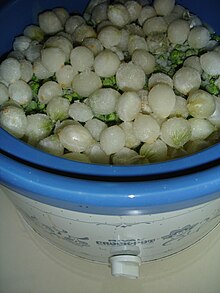Pearl onion

Pearl onions and peas topping a crockpot dish
|
|
| Species | A. ampeloprasum var. sectivum or A. ampeloprasum 'Pearl-Onion Group' |
|---|---|
| Cultivar | 'Pearl onion' |
The "true" pearl onion (A. ampeloprasum var. sectivum or A. ampeloprasum 'Pearl-Onion Group'), (also known as 'button' or 'baby onions' in the UK, or 'creamers 'in the US, ) is a close relative of the leek (A. ampeloprasum var. porrum), and may be distinguished from common onions by having only a single storage leaf, similar to cloves of garlic. In French they are known as 'petit poireau antillais'.
They are cultivated mostly in Germany, the Netherlands, and Italy, usually in home gardens, although formerly on a commercial scale. They are mostly used for pickling.
However, the majority of onions grown for pickling are common onions (A. cepa). They are grown to a small size suitable for pickling by planting at a high density.
Known small white varieties include 'Crystal Wax',(or 'White Bermuda'). but red varieties exist but they are milder in flavour. 'Pearl' onions ready to harvest from seed in 90 days. They an be stored for up to a month in a cool, dry, dark place.
Because of its uniquely small size and a taste sweeter than that of a common onion, it has also been used in dishes ranging from mid-20th-century American casserole dishes such as succotash to sweetly flavored onion relishes in Indian cuisine. It can also be used in stews soups or sauted (fryed) with other vegetables. It can also be used in cocktails such as "martini standing".
'Pearl' onions are, however, a staple to the cuisine of Northern Europe, especially Sweden. Also in modern Europe they are used as a beautiful flowering plant and in Israel as a cut flower.
'Pearl' onions contain chemical compounds that have health benefits including helping cardiovascular health and stabilize blood sugar levels, and acting as an antioxidant and anti-inflammatory.
...
Wikipedia
